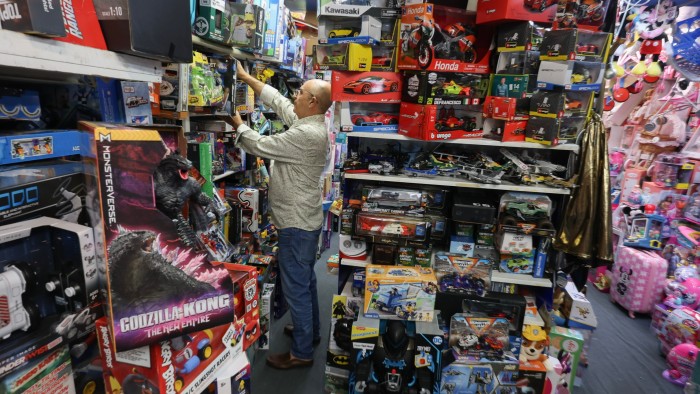Unlock the Editor’s Digest for free
Roula Khalaf, Editor of the FT, selects her favourite stories in this weekly newsletter.
Ports and shipping lines are braced for a “whipsaw” in demand as businesses race to stockpile Black Friday and Christmas goods during the 90-day ceasefire in the US-China trade war.
Analysts warned that the sharp drop-off in container ship bookings from China to the US following President Donald Trump’s April “liberation day” tariff announcements would now be followed by an equally rapid surge in imports that will test port handling capacity.
“First we’ll see a massive drop in cargo arriving in US ports; then a massive surge as goods now waiting on the quayside in China are shipped to the US. It’s a carbon copy of the whipsaw effects we saw in the pandemic,” said Lars Jensen, chief executive of Vespucci Maritime consultancy.
Logistics hub Freightos said it expected “a period of tight capacity and some equipment shortages” as shipping lines and ports try to manage what is expected to be a sudden increase in volumes following the announcement of the 90-day truce by Washington and Beijing on Monday.
The ceasefire deal will slash the headline US tariff on Chinese imports from 145 per cent to 30 per cent for at least 90 days, pending further negotiations between the two sides.
Normally US retailers would import goods for the key Black Friday sales period and Christmas between July and mid-October, but they are now expected to pull orders forward to beat the potential expiry of the trade truce on August 10.
As a result, businesses could face increased container rates and some delays in the next few weeks “at both origins and US destinations”, wrote Judah Levine, head of research at Freightos, in a note to clients on Monday.
The effects of the tariff cut announced on Monday will take time to show up in data, analysts said, with ships taking about 4-6 weeks to reach the US, meaning import freight volumes will continue to fall for the next few weeks.
A wave of cancelled freight bookings in April resulted in almost 400,000 fewer containers booked on Asia-to-North America routes during the four weeks from May 5 than planned, according to shipping data analysts Sea-Intelligence.
Before Monday’s deal, the US National Retail Federation had forecast a 20 per cent year-on-year fall in container shipments to the US from China between June and September.
Although shipping rates are expected to increase, Freightos forecasts that they will probably still remain below last year’s high season rates of $8,000 per 40ft equivalent container to the US West Coast, and more than $9,800/FEU to the East Coast. Before the trade wars broke out, large shipowners had ordered record numbers of new container vessels.
“With rates already more than 30 per cent lower than a year ago due to fleet growth and increased competition between the new carrier alliances, peak season rates may not climb as high as last year’s peak season highs,” Freightos’s Levine added.
However, the full impact of the 90-day truce remained difficult to predict given that US tariff rates on Chinese imports would still be higher than before Trump’s announcements in April, said Sea Intelligence chief executive Alan Murphy.
“Under normal circumstances, an expectation of tariffs would see importers frontloading cargo. In this case though, with the pause still seeing 30 per cent tariffs on Chinese imports, higher than any previous tariffs on China, the incentives are less clear,” Murphy added.
High levels of US stockpiling after Trump was elected in November last year may also ease pressures, some analysts added. US import volumes were 11 per cent higher between November 2024 and April 2025 compared with a year previously, according to National Retail Federation data.
Revolution Beauty plc, a UK-listed mass beauty brand, said in a trading update on Tuesday that it had benefited from stockpiling “significant volumes” of products of Chinese origin in the US before tariffs hit in April, and it was now starting to reauthorise shipments where needed.


